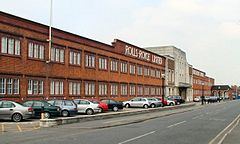
Normanton is an inner city suburb and ward of the city of Derby in Derbyshire, England, situated approximately 2 miles (3.2 km) south of the city centre. Neighbouring suburbs include Littleover, Pear Tree, Rose Hill and Sunny Hill. The original village of Normanton-by-Derby, which now forms the southern part of the suburb, dates back to the medieval period. As the Normanton area became rapidly urbanised in the 19th century, the New Normanton area to the north was developed for housing, linking the old village to Derby, into which it was eventually absorbed. The area is characterised by high density late 19th century terraced housing in New Normanton and mid-20th century housing estates elsewhere, and has the most ethnically diverse population in Derby. The Normanton ward had a population of 17,071 in 2011.

Chaddesden, also known locally as Chadd, is a large residential suburb of Derby, in the ceremonial county of Derbyshire, England. Historically a separate village centred on Chaddesden Hall and the 14th century St Mary's Church, the area was significantly expanded by 20th-century housing developments, and became part of the then County Borough of Derby in 1968, prior to Derby's city status in 1977.

Alvaston is a village and ward of Derby, in the ceremonial county of Derbyshire, England. Alvaston is on the A6 three miles south-east of Derby city centre and probably owes its name to an individual called Ælfwald.
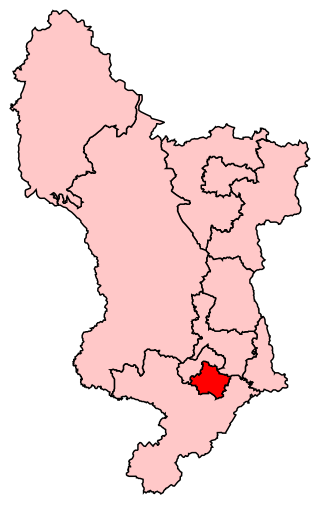
Derby South is a constituency formed of part of the city of Derby represented in the House of Commons of the UK Parliament since 1983 by veteran MP Margaret Beckett of the Labour Party. She has served under the Labour governments of Harold Wilson, James Callaghan, Tony Blair and Gordon Brown. She became interim Leader of the Labour Party in 1994 when John Smith suddenly died. She has also served under Neil Kinnock and Smith himself.

Quarndon is a linear village in the south of the Amber Valley District of Derbyshire, England. It is spread along four minor upland roads, approximately 1 mile north of the Derby suburb of Allestree, two of which lead towards the city.

Wilmorton is a suburb of the city of Derby, England. It is situated between Alvaston and Osmaston, to the south of the city centre on the A6 from Deadman's Lane to the Canal Bridge; the former is aligned to the old town boundary and named from the medieval track that lead to the plague pit dug 1348 during the Great Plague or Black Death. Victims of the Black Death were buried there. It was given the name Wilmorton by the post office in 1887. The area was named after Reverend Sir George Wilmot-Horton, 5th Baronet of Osmaston and was formed out of the Osmaston Hall estate which was broken up in the 1880s.

Peartree railway station is a railway station serving the areas of Pear Tree, Normanton and Osmaston in the city of Derby, England. It is one of three stations remaining open in the city, and is situated about one mile south of Derby station on the main line to Birmingham New Street. For a short period, Derby - Birmingham local services called at Peartree, but it is now served by four trains each way on weekdays on the Crewe–Derby line, a community rail line also known as the North Staffordshire line. The station is owned by Network Rail and managed by East Midlands Railway.
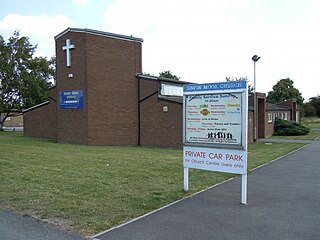
Sinfin is a suburb of Derby, England, 3 miles (4.8 km) southwest of the city centre on its southern outskirts. The ward, which includes Osmaston as well as Sinfin itself, had a population of 15,128 in 2011. Historically, Sinfin and Osmaston were separate villages before being swallowed up by the expansion of Derby. Osmaston is characterised by inter-war housing developments while much of the housing in Sinfin is post-war. Between the two suburbs lies a more industrialised area dominated by the Rolls-Royce works.

Brailsford is a small red-brick village and civil parish in Derbyshire on the A52 midway between Derby and Ashbourne. The parish also includes Brailsford Green. The civil parish population at the 2011 Census was 1,118. The village has a pub, a golf club, a post office and a school. There are many fine houses in the district including two 20th-century country houses: Brailsford Hall built in 1905 in Jacobean style, and Culland Hall.
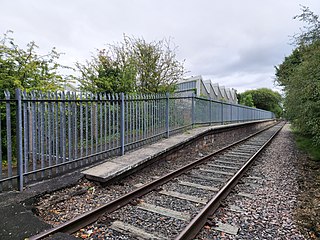
Sinfin Central station was in the city of Derby, Derbyshire, England.

Catton Hall is a country house near the boundary between Derbyshire and Staffordshire, within the civil parish of Catton. It gives its postal address as Walton-on-Trent although there was a village of Catton at one time. It is a Grade II* listed building.

Shottle is a village approximately 3 miles (4.8 km) south of the market town of Wirksworth in Derbyshire. The population of the civil parish at the 2011 Census was 266.
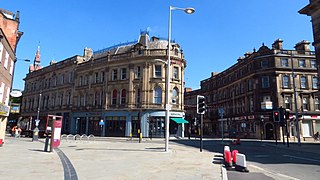
Derby is a city and unitary authority area on the River Derwent in Derbyshire, England. Derbyshire is named after Derby, which was its original county town. As a unitary authority, Derby is administratively independent from Derbyshire County Council. The population of Derby is 261,136 (2021).

Osmaston Hall was a country house built in 1696 in extensive grounds at Osmaston, Derbyshire, now an area of the city of Derby. The house was the home of the Wilmot baronets, and the Fox family before being used for a golf club and railway business. It was demolished in 1938, with the site now occupied by an industrial estate.
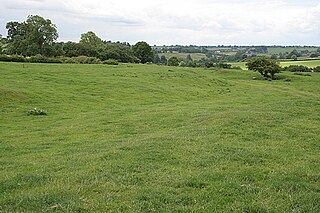
Hungry Bentley is a deserted medieval village and civil parish in the Derbyshire Dales district of Derbyshire, England, between Uttoxeter and Derby. The site is a scheduled monument and has been called the best "depopulated settlement" in Derbyshire. The name Bentley is said to mean a clearing with bent grass. The more unusual appellation of "Hungry" is said to refer to the poor quality of the land and the local inhabitants' poor food.

Catton is a civil parish within the South Derbyshire district, which is in the county of Derbyshire, England. Overwhelmingly rural, its population is reported alongside the adjacent parish of Coton in the Elms for a total of 896 residents in 2011. The parish is 100 miles (160 km) north west of London, 15 miles (24 km) south west of the county city of Derby, and 5 miles (8.0 km) south west of the nearest market town of Burton upon Trent. Being on the edge of the county border, it shares a boundary with the parishes of Coton in the Elms, Lullington and Walton upon Trent in Derbyshire, as well as Barton-under-Needwood, Edingale and Wychnor in Staffordshire. Catton Hall, a historic country house and the surrounding Catton Park are notable for hosting several annual events.
The following is a timeline of the history of the city of Derby, England.

The Rolls-Royce Battle of Britain Memorial Window, is a stained glass window designed by Hugh Ray Easton, to commemorate the pilots of the Royal Air Force who fought in the Battle of Britain and the contribution of Rolls-Royce engineering to their victory. It was unveiled on 11 January 1949 in Rolls-Royce's Nightingale Road factory in Osmaston, Derby.
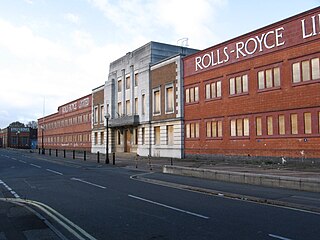
The Marble Hall is an office block of the former Rolls-Royce Limited factory in Osmaston, Derby, in England. The factory was developed from 1907 to manufacture the Rolls-Royce Silver Ghost. The Marble Hall was built in 1912 and was the site of important decisions made during Rolls-Royce's history as a car and aircraft engine manufacturer. The Marble Hall was significantly altered in 1938 adding a classical style entrance way clad in Portland stone and a porte-cochère from which customers could collect their finished cars. The factory closed in 2008, the Marble Hall came into the ownership of Derby City Council and from 2014 was refurbished to provide offices for small and medium-sized enterprises.
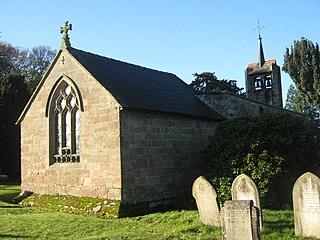
Edlaston and Wyaston is a civil parish within the Derbyshire Dales district, in the county of Derbyshire, England. The parish includes the villages of Edlaston and Wyaston. In 2011 the parish had a population of 220, which increased to 241 in the census of 2021. It is 120 miles (190 km) north west of London, 11 miles (18 km) north west of the county city of Derby, and 2+1⁄2 miles (4 km) south of the market town of Ashbourne. Edlaston and Wyaston touches the parishes of Clifton and Compton, Osmaston, Rodsley, Shirley, Snelston and Yeaveley. There are seven listed buildings in Edlaston and Wyaston.
